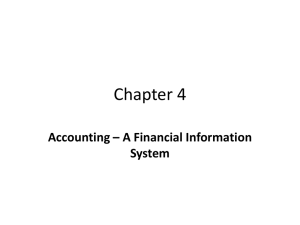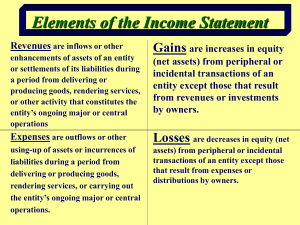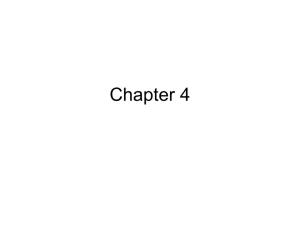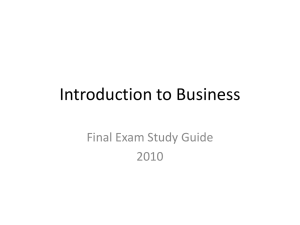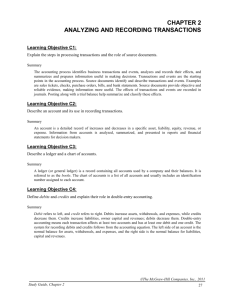Chapter 2 - University of Arkansas at Little Rock
advertisement
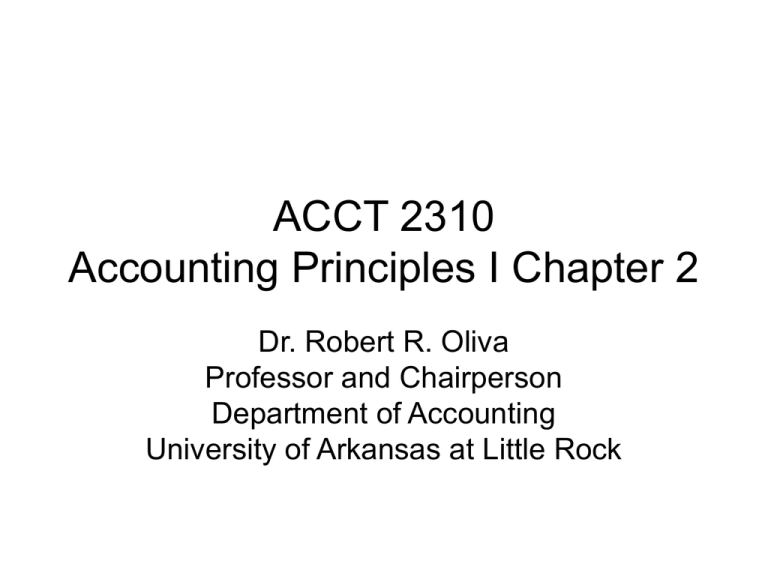
ACCT 2310 Accounting Principles I Chapter 2 Dr. Robert R. Oliva Professor and Chairperson Department of Accounting University of Arkansas at Little Rock Questions: • How do you find out the answer to the following questions? – Does the business have enough cash to buy a $5000 piece of equipment? – Why was a $750 check written on March 28? – How much have you spent on salaries so far this month? – How much did you spend for an ad placed in the Arkansas Democrat Gazette during the first week in July? You need to have an appropriate accounting system in place • JOURNAL: Records daily transactions, describing date, amount, brief explanation. – Pages 62-64. • LEDGER: Keeps a running balance showing increases and decreases of each financial statement item in a separate record, e.g., – Balance sheet: Cash, accounts receivable, etc. – Income Statement: Revenues and expenses. – Pages 65-68 Each business transaction must be recorded • Recording involves a 3-step approach: – Determine which “accounts” are affected. – As the Accounting Equation requires constant balancing, one “account” increases while other “account” decreases. • Double-entry accounting – Translate each increase and decrease into a debit or a credit transaction. • Initial recording done in a “Journal” – The book of original entry • Ledger: After all business transactions are recorded (journalized) then they are posted in the “Ledger” Flow of business transactions • Exhibit 2, page 56 Will proper recording prevent fraud? • Bottom of page 54 But before we can record in a journal or post to a ledger • We need to know what to call each business transaction – We need to separate business transactions into “Accounts” Account classification • Classification depends on the business transaction and the type of business. • Business transactions may be classified as affecting – Assets – Liabilities – Owners’ Equity – Revenues – Expenses Chapter 1: Lawn Mowing example • Many transactions were recorded in Owner’s Equity – Hard to separate and analyze – OK for a very small business. But in reality not very efficient. • More efficient approach: Separate “Owner’s Equity” into various accounts. Owner’s Equity is separated into four (4) separate “accounts”: • Capital – To record owner’s investments • Drawing – To record owner’s withdrawals • Revenue – To record revenues from customers • Expense – To record expenses incurred in business Examples of other “accounts”: • Cash • Supplies • Accounts Payable Accounts Organization Chart of Accounts • Accounts can be classified/organized into 5 major groups/categories: – – – – – Assets Liabilities Owner’s Equity Revenues Expenses • All business have these types, but names and/or numbers given to them will vary. – Unique: The Chart reflects the business transactions. In-class exercise: • Create a Chart of Accounts for Larry Sharp, M.D. • Consider Dr. Sharp’s practice and divide business transactions among the following – Assets – Liabilities – Owners’ Equity – Revenues – Expenses Larry Sharp, M.D. (a sole proprietorship) • Dr. Sharp’s practice has a bank account, supplies, and equipment. • He buys supplies on credit and pays in 30 days • His patients either pay same day or get bills • He rents the office and pays for utilities • He has malpractice insurance which he pays on on 1/1/xx • He has 2 employees and buys them flowers on their birthdays • He attends medical seminars to keep current in his practice. Larry Sharp, M.D. Chart of Accounts • Assets: # 1x – – – – – • Liabilities: # 2x – • 41: Fees earned Expenses; # 5x – – – – – – • 31: Larry Sharp, Capital 32: Larry Sharp, Drawing Revenues: # 4x – • 21: Accounts Payable Owners’ Equity: # 3x – – • 10: Cash 11: Accounts Receivable 12:Supplies 13: Prepaid Insurance 14: Medical equipment 51: Wage expenses 52: Rent expenses 53: Utilities expenses 54: Medical Seminars expenses 55: Supplies expenses 56: Miscellaneous expenses Later we will consider two other accounts: Insurance expense; Depreciation Recall: Why are we classifying the accounts? • To record the business transactions into a journal – Each business transaction requires at least 2 entries to keep the Accounting Equation on balance. What account increases and what account decreases? The hijacking receivable • Page 53 Account Characteristics: pp. 4950 • Form: The “T’ account • Two sides of the “T” – Left side: The debit side – Right side: The credit side • Some accounts increase by “debit” entries • Some account increase by “credit” entries The top of the “T” Describes type of account • Based on the Accounting Equation: Assets = Liabilities + Owner’s Equity • The Accounting Equation determines the recording of an account’s increases and decreases, e.g., Debits and Credits • Page 52 Assets’ Accounts: • Assets increase with “debits”, e.g., increases recorded on the left side of the “T”. – AID • Assets decrease with “credits”, e.g., decreases recorded on the left side of the “T” – ADC Liabilities’ Accounts • Liabilities and Owner’s Equity increase with “credits”, e.g., increases recorded on the left side of the “T”. – LIC • Liabilities and Owners’ Equity decrease with “debits”, e.g., decreases recorded on the left side of the “T” – LDD • Note: Rules mirror each other – Memorize only one A different approach • After eating dinner, let’s read the comics • Using the “T”: – Left: After Eating Dinner: Accounts increasing with debits: • Assets • Expenses • Drawings – Right: Let’s Read the Comics: Accounts increasing with credits: • Liabilities • Revenues • Capital In-class Exercise: Posting entries into “T” accounts • • • • • • • • • • (a) Dr. Sharp deposits $7000 cash in business account (b) Buys $5700 in medical equipment on account. (c) Pays $500 cash for ad in newspaper (d) Pays $75 for supplies. (e) Receives $1000 from patients (f) Pays for the $5700 in equipment. (g) Patients are billed $300 (h) Paid employee $150 (i) Patients in (g) send $300 check in payment. (j) Dr. Sharp withdraws $575 for personal use Solution • Left: After Eating Dinner: Accounts increasing with debits: – Assets – Expenses – Drawings • Right: Let’s Read the Comics: Accounts increasing with credits: – Liabilities – Revenues – Capital Solution: Assets: • Cash account – Debit: (a), (e); and (i) – Credit: (c); (d); (f); (h); (j) • Account receivable – Debit: (g) – Credit: (i) • Supplies: – Debit: (d) • Equipment: – Debit: (b) Solution: Liabilities • Accounts Payable – Credit: (b) – Debit: (f) Solution: Capital, Revenues, Expenses • Capital Account – M. Gordon, Capital: • Credit: (a) – M. Gordon, Drawing: • Debit: (j) • Revenues – Fees earned: • Credit: (e); (g) • Expenses: – Wages • Debit: (h) – Advertising • Debit; (c) But many times proper recoding requires through analysis • Payments in advance Pre-payments paid • Difference between paying for 2-year in advance v. 1-month in advance: – Page 56: Pre-payment of a 2-year policy on December 1st. • Credit cash • Debit an asset – Page 58: Pre-payment of 1-month rent on December 1st. • Credit cash • Debit an expense Pre-payments received • Receiving $360 for prepaid rent 3-months in advance – Page 58 – Debit receipt of $360 cash – Credit a liability: Unearned Revenue • Each month – Debit the liability – Credit revenues Answers to Earlier Questions: • How do you know whether the business has enough cash to buy the equipment? – Ledger: Current balance in the CASH ACCOUNT. • Why was a $750 check written on March 28? – Journal: The journal will show a brief description as to why the check was written. • How much have you spent on salaries so far this month? – Ledger: WAGE EXPENSE ACCOUNT shows balance to date. • How much did you spend for an ad placed in the Arkansas Democrat Gazette during the first week in July? – Journal: Look for entries during the first week in July and look for description indicating the Arkansas Democrat Gazette. TRIAL BALANCE • Reports the balance of each ledger account • Aim: TO show that Debits = Credits In-Class Exercise • Trial balance for Dr. Sharp Dr. Larry Sharp, M.D. Trail Balance May 31, 20xx • • • • • • • • • • Cash………… 1300 Supplies…….. 75 Equipment…. 5700 Dr. L Sharp, Capital Dr. L. Sharp, Drawing 575 Fees earned Wages Expense 150 Advertising Expense 500 _______ 8300 7000 1300 ______ 8300 Possible errors Exhibit 6 • Transposition • Slide Error Correction • Exhibit 7 Errors undetected by a Trial Balance • Failing to record or post a transaction • Recording the same erroneous amounts as debits and credits • Recording the same transaction more than once • Correct debit accompanied by crediting wrong account – Would the trial balance be off if you record a $500 sale on account as follows? • Debited Cash for $500 • Credited Fees earned for $500 – Answer: No! FINANCIAL ANALYSIS • Horizontal analysis – Comparing time periods • Exhibit 8

